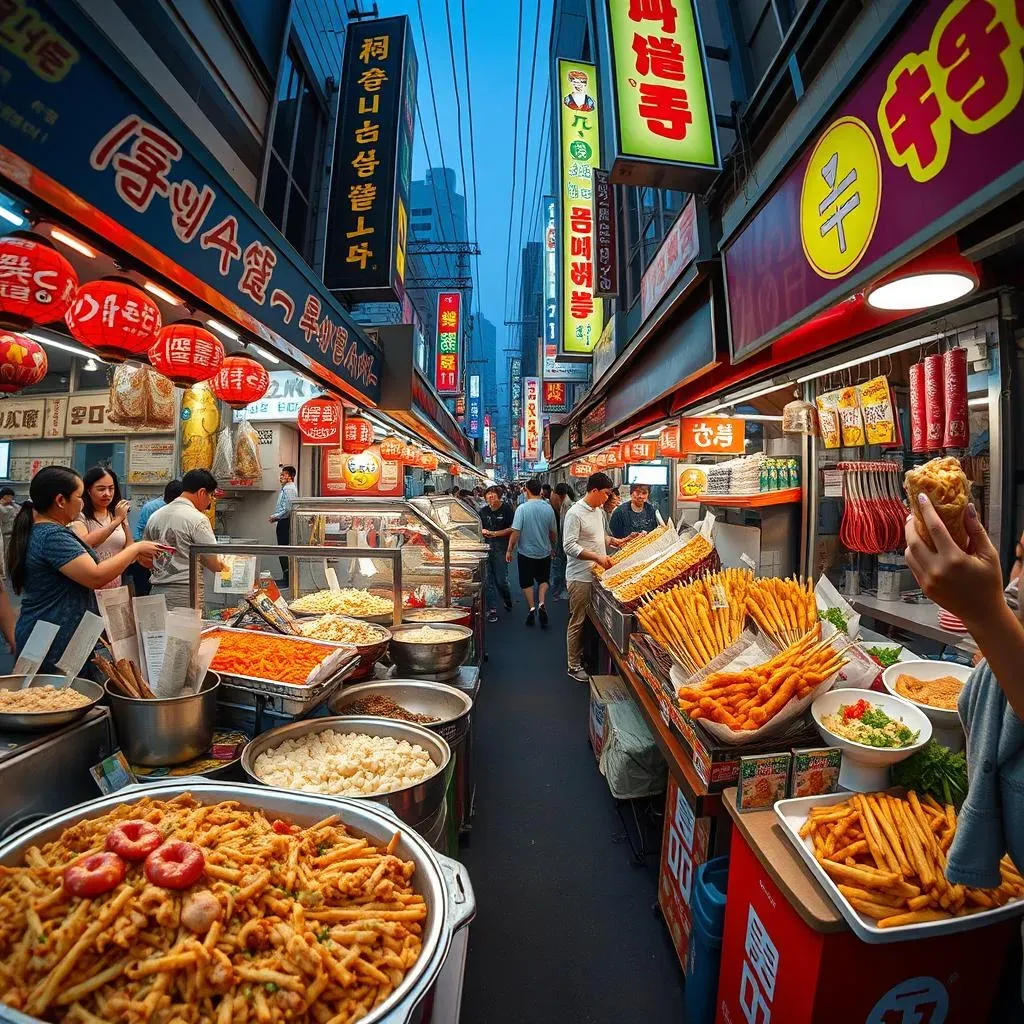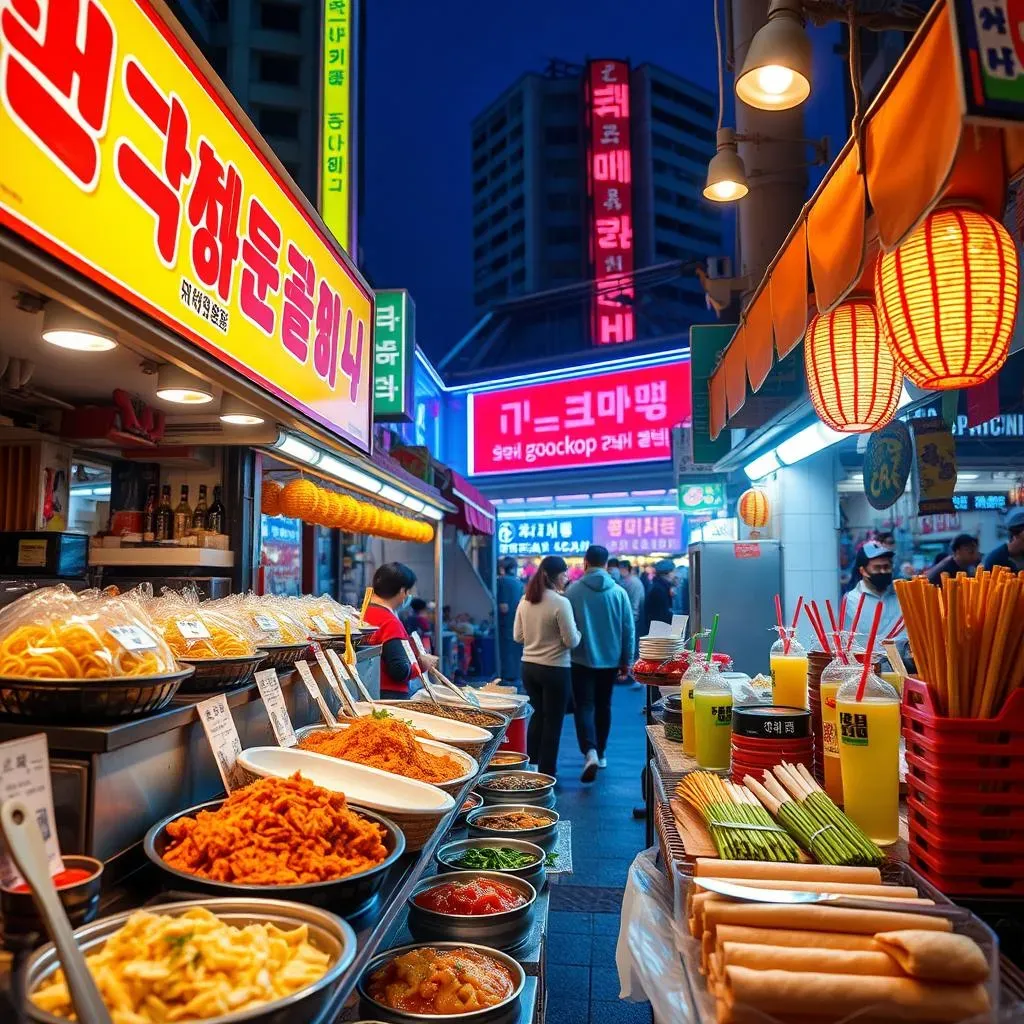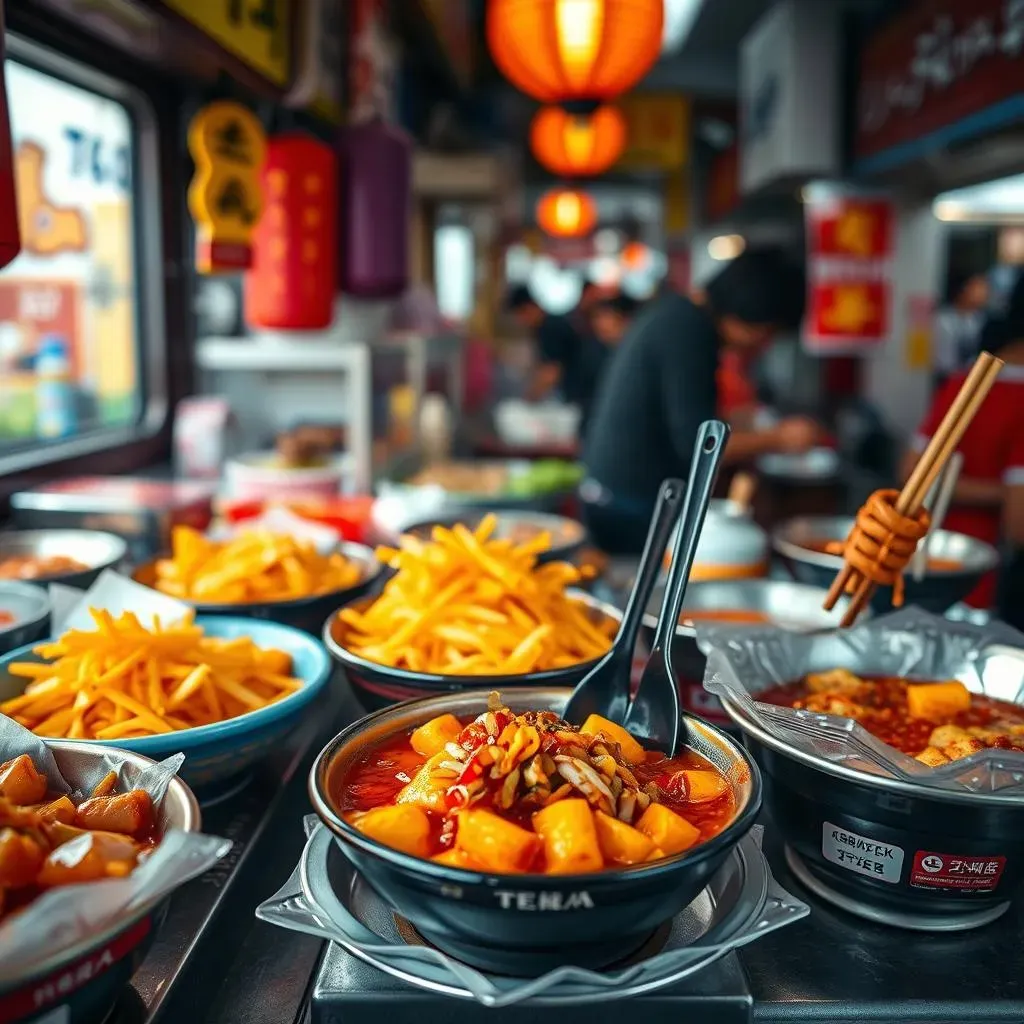Table of Contents
Have you ever wondered what makes Korean street food so incredibly popular? It's more than just tasty snacks; it's a vibrant part of Korean culture, a delicious history lesson served up on a stick, in a cup, or wrapped in a warm pancake. From humble beginnings as an affordable meal option after the Korean War, street food has blossomed into a culinary phenomenon, loved by locals and tourists alike. This isn't just about eating; it's an experience, a journey through flavors and textures that will make your taste buds dance. This article is your guide to the wonderful world of the "korean street food menu". We'll uncover its origins, see how it’s evolved, and most importantly, I'll share 20+ must-try recipes, so you can recreate these amazing dishes in your own kitchen. Get ready to explore the savory, the sweet, and the utterly irresistible world of Korean street food!
The Humble Beginnings of Korean Street Food
The Humble Beginnings of Korean Street Food
Post-War Origins
Okay, so picture this: Korea after the war in the 1950s. It wasn't exactly a picnic. People were struggling, and food was scarce. This is where street food really started to take off. It wasn't some fancy gourmet thing, you know? It was all about quick, cheap, and filling meals. Think of it like survival food, but with a Korean twist. Vendors started setting up stalls, selling simple stuff like rice cakes, noodles, and whatever they could get their hands on. It was a way for people to make a living and for others to get a decent meal without breaking the bank. So, the "korean street food menu" we see today has roots in a time of hardship, born from necessity.
These early street food stalls weren't glamorous. They were often just simple carts or makeshift setups along the roads. But they were lifesavers. They provided warmth, nourishment, and a sense of community during tough times. The food wasn't about elaborate recipes; it was about using what was available and making it taste good. It was the start of something big, something that would become a huge part of Korean culture. This period shaped not only what people ate but how they ate it – quick, on the go, and full of flavor. It’s pretty amazing to think that something born out of difficult times could become such an iconic part of Korean life.
Early Street Food Staples
Let's talk about what people were actually eating back then. We're not talking about fancy cheese-covered corn dogs just yet. Think more along the lines of things that were easy to make and cheap to sell. Tteokbokki, those spicy rice cakes, were an early favorite. They're still a huge deal today, but back then, they were a simple, filling meal that could be made with basic ingredients. And then there was kimbap, the seaweed rice rolls. It's another dish that's stood the test of time, a portable meal perfect for people on the move. These dishes weren’t just food; they were symbols of resilience and resourcefulness.
These early "korean street food menu" items were the foundation of what we see today. They were simple, but they were made with care. These dishes were about more than just filling bellies; they were about connecting people. They were shared among families and friends, and they became a way to bring people together during a challenging time. The flavors and techniques developed then continue to influence Korean street food today. It's a pretty cool story when you think about it, how something so practical could become so iconic.
Early Street Food | Description | Why it was popular |
|---|---|---|
Tteokbokki | Spicy rice cakes | Cheap, filling, and flavorful |
Kimbap | Seaweed rice rolls | Portable, affordable, and versatile |
Evolution of Korean Street Food: From Necessity to Trend
Evolution of Korean Street Food: From Necessity to Trend
The Rise of Variety and Innovation
Okay, so fast forward a bit. Korea started to rebuild, and things got a little more stable. People weren't just looking for something to fill them up; they wanted some flavor, some fun, and maybe a little bit of a show. Street food vendors started experimenting with new ingredients and techniques. It wasn't just about rice cakes and seaweed rolls anymore. We started seeing things like hotteok, those sweet pancakes filled with brown sugar and cinnamon, and the ever-popular Korean corn dogs, which are basically deep-fried masterpieces on a stick. The "korean street food menu" was beginning to get more colorful and exciting, reflecting a growing economy and more diverse tastes.
This period saw a real shift from survival food to a kind of culinary art form. Vendors began to compete, trying to create the most unique and delicious offerings. It wasn't unusual to see street food stalls popping up with their own signature dishes, each one trying to outdo the last. This innovation wasn't just about the food itself; it was also about presentation and the overall experience. Street food became a social event, a way to hang out with friends and try new things. The "korean street food menu" was evolving into something that was both delicious and entertaining.
Global Sensation and Modern Trends
Now, let’s talk about the global phenomenon that is Korean street food. Thanks to the rise of K-pop, K-dramas, and all things Korean, street food has gone international. It's not just something you find in Korea anymore; you can find Korean street food stalls and restaurants all over the world. The "korean street food menu" has become a trendy, must-try experience for foodies everywhere. People are drawn to the unique flavors, the bold spices, and the fun, interactive way that it's often served. It's become a symbol of Korean culture, just like kimchi and K-pop.
Today, Korean street food is as much about Instagram as it is about eating. The vibrant colors, the creative presentations, and the sheer variety of options make it incredibly photogenic. This has helped to fuel its popularity even further. You'll see street food vendors putting on a show, making each dish with flair and precision. It's not just about grabbing a quick bite; it's about enjoying the experience. The "korean street food menu" continues to evolve, blending traditional dishes with modern influences. It’s a testament to the creativity and adaptability of Korean cuisine.
Era | Characteristics | Key Dishes |
|---|---|---|
Post-War | Simple, affordable, and filling | Tteokbokki, Kimbap |
Innovation | Variety, experimentation, and fun | Hotteok, Korean Corn Dogs |
Global | Trendy, photogenic, and widely available | Modern interpretations of classic dishes |
MustTry Korean Street Food Menu: 20+ Recipes
MustTry Korean Street Food Menu: 20+ Recipes
Savory Sensations
Alright, let's get to the good stuff, the "korean street food menu" that you absolutely need to try. We're kicking things off with the savory side, because honestly, who can resist a good, flavorful bite? First up, we gotta talk about Tteokbokki. Seriously, if you haven't had it, you're missing out. These chewy rice cakes swimming in a spicy, sweet, and savory sauce are a true Korean street food staple. It's the kind of dish that warms you up from the inside out. Then, there's Kimbap, the Korean version of sushi, but way more portable and fun. These seaweed rice rolls are packed with veggies, meat, and a whole lot of flavor. They're perfect for a quick bite or a full meal. You'll also find things like Odeng, which is fish cake skewers in a savory broth, and Mandu, Korean dumplings that are crispy and delicious.
Let's not forget about the Korean street toast, or Gilgeori toast. It's not your average toast, it's a mix of savory and sweet, with a fried egg, cabbage, and a hint of sugar. It's a breakfast item that's also perfect for any time of the day. And then there's the classic Korean corn dog, which is a whole other level of deliciousness. It's a hotdog coated in a batter, deep-fried until golden, and then often sprinkled with sugar. The "korean street food menu" here is about variety, from the spicy kick of Tteokbokki to the comforting flavors of Kimbap. Each dish is an adventure for your tastebuds.
Sweet Treats and More
Okay, now that we’ve covered the savory side, let's move on to the sweet treats. The "korean street food menu" is definitely not complete without these goodies. First up, we have the iconic Hotteok. These sweet pancakes are crispy on the outside and gooey on the inside, filled with a mix of brown sugar, cinnamon, and nuts. They’re warm, comforting, and absolutely addictive. Then there's Bungeoppang, which are fish-shaped pastries filled with sweet red bean paste. They're adorable and delicious, a perfect sweet treat. You might also find Gyeranppang, or egg bread, which is a sweet and savory muffin-like cake with an egg baked right in the middle.
And for something a bit different, try some Korean shaved ice, or Bingsu. It’s a mountain of fluffy shaved ice topped with sweet toppings like fruit, condensed milk, and red bean paste. It's a refreshing treat, especially on a hot day. These sweet options show that the "korean street food menu" isn't just about savory dishes; it's also about satisfying that sweet tooth. From the warm, gooey Hotteok to the cool, refreshing Bingsu, there's a perfect dessert for every mood. So, whether you're craving something spicy or sweet, Korean street food has you covered. It’s a culinary adventure that’s both exciting and comforting, making it a must-try for everyone.
Dish | Type | Description |
|---|---|---|
Tteokbokki | Savory | Spicy rice cakes in a gochujang sauce |
Kimbap | Savory | Seaweed rice rolls with various fillings |
Hotteok | Sweet | Sweet pancakes with brown sugar and cinnamon |
Bungeoppang | Sweet | Fish-shaped pastries with red bean paste |
Bringing the Flavors Home: Easy Korean Street Food Recipes
Bringing the Flavors Home: Easy Korean Street Food Recipes
Tteokbokki Time: Spicy Rice Cakes Made Simple
Okay, let's talk Tteokbokki, that spicy, chewy goodness. You might think it's super hard to make, but trust me, it’s not. The key is getting the sauce right, and it's easier than you think. We’re talking gochujang (Korean chili paste), soy sauce, a touch of sugar, and some garlic. You mix that with water and bring it to a simmer, then toss in the rice cakes and some fish cakes if you’re feeling fancy. And there you have it, spicy, chewy perfection. It's one of those dishes that's super customizable, so feel free to add veggies or even some ramen noodles. The "korean street food menu" at home starts with mastering this classic, and you'll be surprised how easily it comes together.
Don't be scared to adjust the spice level to your liking. If you're not a fan of super-hot food, start with a smaller amount of gochujang and add more to taste. The beauty of making it at home is that you can make it exactly how you like it. And the best part? It’s quick! You can whip up a batch of Tteokbokki in under 30 minutes, making it a perfect weeknight meal. It's a great way to impress your friends or family with your new-found Korean street food skills. The "korean street food menu" is now at your fingertips, and it's all about having fun and experimenting with flavors.
Ingredient | Purpose |
|---|---|
Gochujang | Adds spice and depth |
Rice Cakes | Provides the chewy texture |
Soy Sauce | Adds umami and saltiness |
Hotteok Happiness: Sweet Pancakes at Your Fingertips
Now, let's move on to something sweet, Hotteok. These little pancakes of joy are easier to make than you might think. It's all about the dough, which is a simple mix of flour, yeast, sugar, and a pinch of salt. Let it rise, then stuff it with a mixture of brown sugar, cinnamon, and chopped nuts. Fry it up until golden brown and crispy, and boom, you have a warm, gooey treat that will make you feel like you’re right in the middle of a Korean street market. The "korean street food menu" at home wouldn't be complete without these sweet delights, and they’re surprisingly simple to whip up.
What I love about making Hotteok at home is that you can customize the filling. If you’re not a fan of nuts, you can leave them out or use a different kind. You can even add a touch of honey or some other spices. It's all about making it your own. And the smell while they’re cooking? Absolutely amazing! These are perfect for a weekend treat or a fun activity with kids. It's like bringing a little piece of Korea right into your kitchen. The "korean street food menu" is not just about savory; it's about the sweet moments too, and Hotteok definitely delivers on that front.
- Use warm water to activate the yeast for the dough.
- Don’t overfill the dough with the filling.
- Fry on medium heat to ensure they cook through.